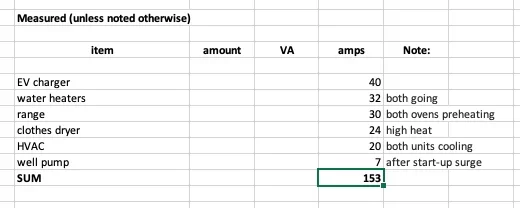I need to replace my HVAC system soon (it's 26 years old now, and only still running through the selfless and heroic efforts of the moonlighting cryogenic tech who installed it, and the fact I heat almost entirely with wood). It's a dual-fuel system, heat pump with propane backup, and I'd like to ditch the propane. It seems that some of the newer heat pumps might suffice without backup (the cold-weather design temp here is 20 degrees) but I'd feel more comfortable with some electric resistance backup (aka. heat strips). So I'm trying to figure out how much electrical reserve I have, in my 200amp service. (This is a spinoff from a discussion about my heat pump frying contactors).
Rather than do the Section 220 calculation, I've decided to do measurements. Rather than try to max out the house consumption and measure everything, I tried to measure each big load independently (except the EVSE, which is well-defined) Here's what I've got so far:

This accounts for all my 240vac loads, except for the shipping container workshop. Note that it's a pretty pessimistic situation. The EV is charging. Both water heaters are kicking in after peak electric hours have ended (I'm on a time-of-day usage billing plan). My main HVAC plus a minisplit in an addition are running. Both ovens in the range are pre-heating. The clothes-dryer is running on max heat. And the well pump is going.
But there are some other potentially significant loads. Refrigerator might be auto-defrosting (only 100 watts or so otherwise). Dishwasher pre-heating water. Washing machine. Central vacuum. Small compressor in the workshop. Misc kitchen loads (electric kettle, microwave). The Section 220 allocation of 3VA/ft^2 for lighting gives me another 20 amps or so, but that's wildly pessimistic in the age of LED lights.
So what do you think ? How many amps of heat strips would you feel comfortable with ?
Rather than do the Section 220 calculation, I've decided to do measurements. Rather than try to max out the house consumption and measure everything, I tried to measure each big load independently (except the EVSE, which is well-defined) Here's what I've got so far:

This accounts for all my 240vac loads, except for the shipping container workshop. Note that it's a pretty pessimistic situation. The EV is charging. Both water heaters are kicking in after peak electric hours have ended (I'm on a time-of-day usage billing plan). My main HVAC plus a minisplit in an addition are running. Both ovens in the range are pre-heating. The clothes-dryer is running on max heat. And the well pump is going.
But there are some other potentially significant loads. Refrigerator might be auto-defrosting (only 100 watts or so otherwise). Dishwasher pre-heating water. Washing machine. Central vacuum. Small compressor in the workshop. Misc kitchen loads (electric kettle, microwave). The Section 220 allocation of 3VA/ft^2 for lighting gives me another 20 amps or so, but that's wildly pessimistic in the age of LED lights.
So what do you think ? How many amps of heat strips would you feel comfortable with ?

